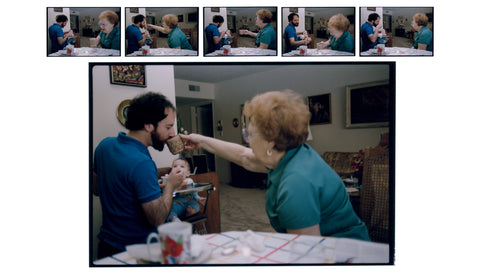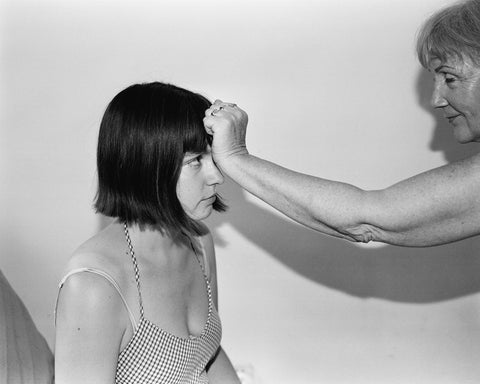 Catherine Opie, Hilton, 2013
Catherine Opie, Hilton, 2013
To hold together Catherine Opie and Brigitte Lacombe’s works is to revel in the similarities between them. They each take pictures that telegraph a highly ethical interaction between the sitter and the photographer. Gazes are direct. The sitters’ bodies are arranged in a way that is clear: transparent. Each image says, “We were here, in this room, together.” There are no bells and whistles—no overt manipulation of the image, the conventions of portraiture, or the body and face of the sitter. They do not rely on scale (think Thomas Ruff or Chuck Close), or mise-en-scène (think Annie Leibovitz). Both artists partake in the longue durée of portraiture in the West, from its Renaissance conventions of foregrounding the head and shoulders of the sitter, to more recent codes—bright irises, parted mouths, a faraway gaze—associated with the relentlessness of the celebrity image. Both artists alternate between posing their subjects and capturing the quality of a passing, unguarded moment. Both situate their sitters against a monochromatic background, a device that heightens the individuality of the person being photographed. Conversely, both repeatedly use the same set-up, which heightens the parity of the individuals being imaged. Both produce prints just barely larger than life-size, a scale that encourages intimacy while insisting on the picture’s remove from everyday life.
The contrasts are equally important. Opie’s portraits of artists show her subjects in existential repose, while Lacombe stages encounters designed to convey her subjects’ life force or vivacity. Opie’s portraits take their temporal cues from paintings, while Lacombe’s draw from cinema. Looking at their portraits of the same person only heightens these distinctions. Take, for example, Opie’s portrait of Hilton Als. The writer is seated. His husky frame fills the chair, which also reads somewhat like a throne, an allusion borne out by Als’s gravitas and sense of composure. His hands are folded neatly in his lap, and light graces his left cheek. Wearing a classic ticking stripe suit jacket, the draw of the image—my punctum—is the pen tucked in the pocket where a folded handkerchief might have gone. The pen conveys the casual nonchalance of the writer who always has his tool at hand, the slight anxiety that would cause one to carry a pen at all times, and the persistence of the analogue in the face of the digital (this simple, ubiquitous pen does a lot of work in this image). In keeping with his regal comportment, his visage is redolent of the expression, “heavy is the head that wears the crown.” But this heaviness is not that of the monarch but the public intellectual: Als is a figure writing in the spirit and legacy of essayists such as James Baldwin and Elizabeth Hardwick. And he embodies this role at a time when its framing terms, “public” and “intellectual,” find themselves under great pressure.
 Brigitte Lacombe, Hilton Als, New York, NY, 2020
Brigitte Lacombe, Hilton Als, New York, NY, 2020
Lacombe’s photograph offers a different version of the writer. In her image, his face fills the frame. There is a hint of movement: traces of energy that linger in the crinkles around his eyes, the slight blur by his left ear. The punctum is the gap between his two front teeth, as ravishing as the gap made famous by actress and model Lauren Hutton. In Lacombe’s picture, Als’s face is inflected by joy. Rather than introspection, we see the artist in a moment of recognizing that it is he who is being seen. The evidence of this encounter is the pleasure that dances around his eyes. This particular quality of “being-seen-ness” occurs in Lacombe’s portrait of Richard Avedon as well. I find the similarities between the portraits of Als and Avedon striking. Both are cultural observers known for their sharpness, yet they seem to relish the surprise and intimacy of their encounter with Lacombe and her camera.
When it comes to taking pictures of artists, Lacombe is most interested in the residue or trace of an encounter. Her project suggests that all artists are attuned to the accidental, the providential, the ineffable, and she is interested in depicting the fleeting, electrically charged moment. Opie, by contrast, pursues images that capture the existential quality of interiority. Her portraits suggest that all artists require access to, and the ability to reside in, the quiet reaches of their own mind and body. Her portraits bear witness to how this interiority opens onto melancholy, defiance, acceptance of the passage of time, and time’s ultimate registration: death. Hence the fragility of Lawrence Weiner’s aging skin or the beatific, sorrowful gaze of John Baldessari. Regardless, this is not a dialectic in need of resolution or synthesis. There is no choosing here, only enumeration. These are artists picturing their community of makers, thinkers, and writers. These are projects driven by admiration and love.
Extracted from Helen Molesworth’s essay ‘Say Yes to Life’ from Face to Face: Face to Face: Portraits of Artists by Tacita Dean, Brigitte Lacombe, and Catherine Opie ed. by Helen Molesworth

Paperback with PVC jacket
24 x 29 cm, 164 pages
€40 £35 $45





